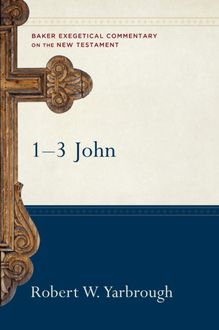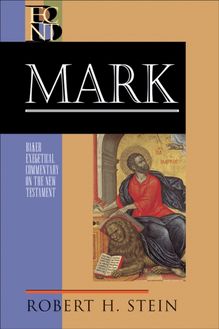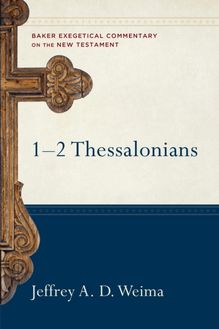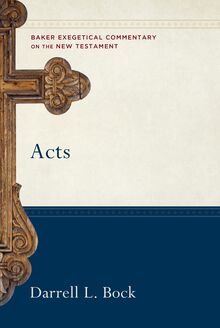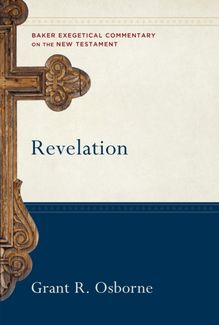-
 Univers
Univers
-
 Ebooks
Ebooks
-
 Livres audio
Livres audio
-
 Presse
Presse
-
 Podcasts
Podcasts
-
 BD
BD
-
 Documents
Documents
-
- Cours
- Révisions
- Ressources pédagogiques
- Sciences de l’éducation
- Manuels scolaires
- Langues
- Travaux de classe
- Annales de BEP
- Etudes supérieures
- Maternelle et primaire
- Fiches de lecture
- Orientation scolaire
- Méthodologie
- Corrigés de devoir
- Annales d’examens et concours
- Annales du bac
- Annales du brevet
- Rapports de stage
La lecture à portée de main
Vous pourrez modifier la taille du texte de cet ouvrage
Découvre YouScribe en t'inscrivant gratuitement
Je m'inscrisMark (Baker Exegetical Commentary on the New Testament) , livre ebook
Découvre YouScribe en t'inscrivant gratuitement
Je m'inscrisEn savoir plus
Vous pourrez modifier la taille du texte de cet ouvrage
En savoir plus

Description
Sujets
Informations
| Publié par | Baker Publishing Group |
| Date de parution | 01 novembre 2008 |
| Nombre de lectures | 0 |
| EAN13 | 9781441210623 |
| Langue | English |
| Poids de l'ouvrage | 3 Mo |
Informations légales : prix de location à la page 0,1440€. Cette information est donnée uniquement à titre indicatif conformément à la législation en vigueur.
Extrait
BAKER EXEGETICAL COMMENTARY ON THE NEW TESTAMENT
ROBERT W. YARBROUGH and JOSHUA W. JIPP, EDITORS
Volumes now available:
Matthew David L. Turner
Mark Robert H. Stein
Luke Darrell L. Bock
Acts Darrell L. Bock
Romans, 2nd ed. Thomas R. Schreiner
1 Corinthians David E. Garland
2 Corinthians George H. Guthrie
Galatians Douglas J. Moo
Ephesians Frank Thielman
Philippians Moisés Silva
Colossians and Philemon G. K. Beale
1–2 Thessalonians Jeffrey A. D. Weima
James Dan G. McCartney
1 Peter Karen H. Jobes
1–3 John Robert W. Yarbrough
Jude and 2 Peter Gene L. Green
Revelation Grant R. Osborne
***
Robert H. Stein (PhD, Princeton Theological Seminary) taught New Testament studies for many years at both Bethel Seminary and the Southern Baptist Theological Seminary. Specializing in Gospel interpretation and hermeneutics, he has written A Basic Guide to Interpreting the Bible , Studying the Synoptic Gospels , The Method and Message of Jesus’ Teachings , Jesus the Messiah , and a commentary on the Gospel of Luke.
© 2008 by Robert H. Stein
Published by Baker Academic a division of Baker Publishing Group P.O. Box 6287, Grand Rapids, MI 49516-6287 www.bakeracademic.com
Ebook edition created 2014
Ebook corrections 11.05.2021
All rights reserved. No part of this publication may be reproduced, stored in a retrieval system, or transmitted in any form or by any means—for example, electronic, photocopy, recording—without the prior written permission of the publisher. The only exception is brief quotations in printed reviews.
Library of Congress Cataloging-in-Publication Data is on file at the Library of Congress, Washington, DC.
ISBN 978-1-4412-1062-3
To my grandchildren: Samuel, Matthew, Daniel, Jacob, and Julia
With the prayer that they will love and serve
“Jesus Christ, the Son of God” (Mark 1:1)
Contents
Cover
Series Page
Title Page
Copyright Page
Dedication
Series Preface
Author’s Preface
Abbreviations
Transliteration
Map
Introduction to the Gospel of Mark
I. Prologue: The Beginning of the Good News about Jesus Christ, the Son of God (1:1–13)
A. The Witness of John the Baptist to Jesus (1:1–8)
B. The Baptism of Jesus (1:9–11)
C. The Temptation of Jesus (1:12–13)
II. Who Is This Jesus? Part 1 (1:14–3:6)
A. A Summary of Jesus’s Message (1:14–15)
B. Jesus Calls the First Disciples (1:16–20)
C. Jesus’s Healing Ministry in Capernaum and Galilee (1:21–45)
D. Jesus’s Mighty Acts in Capernaum and Galilee (2:1–3:6)
III. Who Is This Jesus? Part 2 (3:7–6:6a)
A. A Summary of Jesus’s Ministry (3:7–12)
B. Jesus Calls the Twelve Apostles (3:13–19)
C. Jesus, His Family, and Beelzebul (3:20–35)
D. Jesus Teaches in Parables (4:1–34)
E. Jesus—Lord of Nature, Demons, Disease, and Death (4:35–5:43)
F. Jesus Encounters Unbelief in Nazareth (6:1–6a)
IV. Mission and Misunderstanding: Part 3 (6:6b–8:21)
A. A Summary of Jesus’s Ministry and the Mission of His Disciples (6:6b–13)
B. The Death of John the Baptist (6:14–29)
C. Jesus Feeds the Five Thousand (6:30–44)
D. Jesus Walks on the Sea (6:45–52)
E. A Summary of Jesus’s Healings at Gennesaret (6:53–56)
F. Jesus and the Tradition of the Elders (7:1–23)
G. Jesus and the Syrophoenician Woman (7:24–30)
H. Jesus Heals a Deaf Mute (7:31–37)
I. Jesus Feeds the Four Thousand (8:1–9)
J. Jesus Is Asked for a Sign (8:10–13)
K. Jesus’s Miracles of the Two Feedings Recalled (8:14–21)
V. On the Way to Jerusalem: Part 4 (8:22–10:52)
A. Jesus Heals the Blind Man of Bethsaida (8:22–26)
B. Peter’s Confession and Jesus’s First Passion Prediction (8:27–33)
C. Jesus’s Invitation to Discipleship (8:34–9:1)
D. Jesus Is Transfigured (9:2–8)
E. The Son of Man and the Return of Elijah (9:9–13)
F. Jesus Performs a Difficult Exorcism (9:14–29)
G. Jesus’s Second Passion Prediction (9:30–32)
H. Jesus’s Teachings on Discipleship (9:33–50)
I. Jesus’s Teaching concerning Divorce (10:1–12)
J. Jesus Blesses the Children (10:13–16)
K. Jesus, the Rich Man, and Eternal Life (10:17–31)
L. Jesus’s Third Passion Prediction (10:32–34)
M. The Misguided Request of James and John (10:35–45)
N. Jesus Heals a Second Blind Man (10:46–52)
VI. Jesus’s Entry into Jerusalem: Part 5 (11:1–13:37)
A. Jesus’s Messianic Entry into Jerusalem (11:1–11)
B. Jesus’s Judgment of the Fig Tree and the Temple (11:12–25)
C. Jesus Questioned concerning His Authority (11:27–33)
D. Jesus’s Parable of the Vineyard (12:1–12)
E. The Pharisees and Herodians Seek to Trick Jesus (12:13–17)
F. The Sadducees Seek to Trick Jesus (12:18–27)
G. A Scribe Asks Jesus about the Great Commandment (12:28–34)
H. Jesus’s Question concerning the Messiah (12:35–37)
I. Jesus’s Denunciation of the Scribes (12:38–40)
J. Jesus’s Teaching concerning the Widow’s Great Gift (12:41–44)
K. Jesus’s Eschatological Discourse (13:1–37)
VII. The Passion Narrative: Part 6 (14:1–16:8)
A. The Plot to Kill Jesus, and His Anointing by an Unnamed Woman (14:1–11)
B. The Last Supper and Jesus’s Prediction of the Denial of the Disciples (14:12–31)
C. Jesus Prays in the Garden of Gethsemane (14:32–42)
D. Jesus Is Seized (14:43–52)
E. Jesus Is Tried by the Sanhedrin (14:53–65)
F. Jesus Is Denied by Peter (14:66–72)
G. Jesus Is Tried by Pontius Pilate (15:1–15)
H. Jesus Is Crucified (15:16–41)
I. Jesus Is Buried (15:42–47)
J. Jesus Is Raised from the Dead (16:1–8)
Works Cited
Index of Subjects
Index of Authors
Index of Greek Words
Index of Scripture and Other Ancient Writings
Notes
Back Cover
Series Preface
The chief concern of the Baker Exegetical Commentary on the New Testament (BECNT) is to provide, within the framework of informed evangelical thought, commentaries that blend scholarly depth with readability, exegetical detail with sensitivity to the whole, and attention to critical problems with theological awareness. We hope thereby to attract the interest of a fairly wide audience, from the scholar who is looking for a thoughtful and independent examination of the text to the motivated lay Christian who craves a solid but accessible exposition.
Nevertheless, a major purpose is to address the needs of pastors and others involved in the preaching and exposition of the Scriptures as the uniquely inspired Word of God. This consideration affects directly the parameters of the series. For example, serious biblical expositors cannot afford to depend on a superficial treatment that avoids the difficult questions, but neither are they interested in encyclopedic commentaries that seek to cover every conceivable issue that may arise. Our aim therefore is to focus on problems that have a direct bearing on the meaning of the text (although selected technical details are treated in the additional notes).
Similarly, a special effort is made to avoid treating exegetical questions for their own sake, that is, in relative isolation from the thrust of the argument as a whole. This effort may involve (at the discretion of the individual contributors) abandoning the verse-by-verse approach in favor of an exposition that focuses on the paragraph as the main unit of thought. In all cases, however, the commentaries will stress the development of the argument and explicitly relate each passage to what precedes and follows it so as to identify its function in context as clearly as possible.
We believe, moreover, that a responsible exegetical commentary must take fully into account the latest scholarly research, regardless of its source. The attempt to do this in the context of a conservative theological tradition presents certain challenges, and in the past the results have not always been commendable. In some cases, evangelicals appear to make use of critical scholarship not for the purpose of genuine interaction but only to dismiss it. In other cases, the interaction glides over into assimilation, theological distinctives are ignored or suppressed, and the end product cannot be differentiated from works that arise from a fundamentally different starting point.
The contributors to this series attempt to avoid these pitfalls. On the one hand, they do not consider traditional opinions to be sacrosanct, and they are certainly committed to do justice to the biblical text whether or not it supports such opinions. On the other hand, they will not quickly abandon a long-standing view, if there is persuasive evidence in its favor, for the sake of fashionable theories. What is more important, the contributors share a belief in the trustworthiness and essential unity of Scripture. They also consider that the historic formulations of Christian doctrine, such as the ecumenical creeds and many of the documents originating in the sixteenth-century Reformation, arose from a legitimate reading of Scripture, thus providing a proper framework for its further interpretation. No doubt, the use of such a starting point sometimes results in the imposition of a foreign construct on the text, but we deny that it must necessarily do so or that the writers who claim to approach the text without prejudices are invulnerable to the same danger.
Accordingly, we do not consider theological assumptions—from which, in any case, no commentator is free—to be obstacles to biblical interpretation. On the contrary, an exegete who hopes to understand the apostle Paul in a theological vacuum might just as easily try to interpret Aristotle without regard for the philosophical framework of his whole work or without having recourse to the subsequent philosophical categories that make possible a meaningful contextualization of his thought. It must be emphasized, however, that the contributors to the present series come from a variety of theological traditions and that they do not all have identical views with regard to the proper implementation of these general principles. In the end, all that really matters is whether the series succeeds in representing the original tex
-
 Univers
Univers
-
 Ebooks
Ebooks
-
 Livres audio
Livres audio
-
 Presse
Presse
-
 Podcasts
Podcasts
-
 BD
BD
-
 Documents
Documents
-
Jeunesse
-
Littérature
-
Ressources professionnelles
-
Santé et bien-être
-
Savoirs
-
Education
-
Loisirs et hobbies
-
Art, musique et cinéma
-
Actualité et débat de société
-
Jeunesse
-
Littérature
-
Ressources professionnelles
-
Santé et bien-être
-
Savoirs
-
Education
-
Loisirs et hobbies
-
Art, musique et cinéma
-
Actualité et débat de société
-
Actualités
-
Lifestyle
-
Presse jeunesse
-
Presse professionnelle
-
Pratique
-
Presse sportive
-
Presse internationale
-
Culture & Médias
-
Action et Aventures
-
Science-fiction et Fantasy
-
Société
-
Jeunesse
-
Littérature
-
Ressources professionnelles
-
Santé et bien-être
-
Savoirs
-
Education
-
Loisirs et hobbies
-
Art, musique et cinéma
-
Actualité et débat de société
- Cours
- Révisions
- Ressources pédagogiques
- Sciences de l’éducation
- Manuels scolaires
- Langues
- Travaux de classe
- Annales de BEP
- Etudes supérieures
- Maternelle et primaire
- Fiches de lecture
- Orientation scolaire
- Méthodologie
- Corrigés de devoir
- Annales d’examens et concours
- Annales du bac
- Annales du brevet
- Rapports de stage




